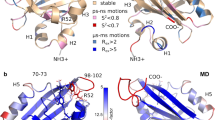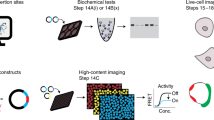Abstract
We demonstrate the site-directed incorporation of an IR-active amino acid, p-azido-L-phenylalanine (azidoF, 1), into the G protein–coupled receptor rhodopsin using amber codon suppression technology. The antisymmetric stretch vibration of the azido group absorbs at ∼2,100 cm−1 in a clear spectral window and is sensitive to its electrostatic environment. We used FTIR difference spectroscopy to monitor the azido probe and show that the electrostatic environments of specific interhelical networks change during receptor activation.
This is a preview of subscription content, access via your institution
Access options
Subscribe to this journal
Receive 12 print issues and online access
$259.00 per year
only $21.58 per issue
Buy this article
- Purchase on Springer Link
- Instant access to full article PDF
Prices may be subject to local taxes which are calculated during checkout



Similar content being viewed by others
References
Pierce, K.L ., Premont, R.T . & Lefkowitz, R.J . Nat. Rev. Mol. Cell Biol. 3, 639–650 (2002).
Huber, T., Menon, S. & Sakmar, T.P. Biochemistry 47, 11013–11023 (2008).
Kobilka, B. & Schertler, G.F.X. Trends Pharmacol. Sci. 29, 79–83 (2008).
Hanson, M.A. & Stevens, R.C. Structure 17, 8–14 (2009).
Mahalingam, M., Martinez-Mayorga, K., Brown, M.F. & Vogel, R. Proc. Natl. Acad. Sci. USA 105, 17795–17800 (2008).
Vogel, R. et al. J. Mol. Biol. 380, 648–655 (2008).
Noren, C.J., Anthonycahill, S.J., Griffith, M.C. & Schultz, P.G. Science 244, 182–188 (1989).
Wang, L., Brock, A., Herberich, B. & Schultz, P.G. Science 292, 498–500 (2001).
Sakamoto, K. et al. Nucleic Acids Res. 30, 4692–4699 (2002).
Schultz, K.C. et al. J. Am. Chem. Soc. 128, 13984–13985 (2006).
Ohno, S. et al. J. Biochem 141, 335–343 (2007).
Liu, W.S., Brock, A., Chen, S., Chen, S.B. & Schultz, P.G. Nat. Methods 4, 239–244 (2007).
Ye, S.X. et al. J. Biol. Chem 283, 1525–1533 (2008).
Silverman, L.N., Pitzer, M.E., Ankomah, P.O., Boxer, S.G. & Fenlon, E.E. J. Phys. Chem. B 111, 11611–11613 (2007).
Suydam, I.T., Snow, C.D., Pande, V.S. & Boxer, S.G. Science 313, 200–204 (2006).
Chin, J.W. et al. Science 301, 964–967 (2003).
Hubbell, W.L., Altenbach, C., Hubbell, C.M. & Khorana, H.G. Adv. Protein Chem. 63, 243–290 (2003).
Li, J., Edwards, P.C., Burghammer, M., Villa, C. & Schertler, G.F.X. J. Mol. Biol. 343, 1409–1438 (2004).
Park, J.H., Scheerer, P., Hofmann, K.P., Choe, H.W. & Ernst, O.P. Nature 454, 183–187 (2008).
Huber, T., Botelho, A.V., Beyer, K. & Brown, M.F. Biophys. J. 86, 2078–2100 (2004).
Dunham, T.D. & Farrens, D.L. J. Biol. Chem. 274, 1683–1690 (1999).
Farrens, D.L., Altenbach, C., Yang, K., Hubbell, W.L. & Khorana, H.G. Science 274, 768–770 (1996).
Patel, A.B. et al. Proc. Natl. Acad. Sci. USA 101, 10048–10053 (2004).
Kobilka, B.K. & Deupi, X. Trends Pharmacol. Sci. 28, 397–406 (2007).
Scheerer, P. et al. Nature 455, 497–502 (2008).
Acknowledgements
We thank S. Banerjee, T. Haines, U.L. RajBhandary, C. Köhrer and M.S. Sagredo for invaluable discussions. We are also grateful to the Proteomic Resource Center at The Rockefeller University for providing technical resources. Financial support was provided by the Deutsche Forschungsgemeinschaft (grant Vo 811/4-1 to R.V.) and by a C.H. Li Memorial Scholar Award (to S.Y.).
Author information
Authors and Affiliations
Contributions
S.Y., T.H. and R.V. designed and conducted experiments, analyzed data and wrote the manuscript. T.P.S. designed experiments and wrote the manuscript.
Corresponding author
Supplementary information
Supplementary Text and Figures
Supplementary Figures 1 and 2, and Supplementary Methods (PDF 135 kb)
Rights and permissions
About this article
Cite this article
Ye, S., Huber, T., Vogel, R. et al. FTIR analysis of GPCR activation using azido probes. Nat Chem Biol 5, 397–399 (2009). https://doi.org/10.1038/nchembio.167
Received:
Accepted:
Published:
Issue Date:
DOI: https://doi.org/10.1038/nchembio.167
This article is cited by
-
Interdisciplinary biophysical studies of membrane proteins bacteriorhodopsin and rhodopsin
Biophysical Reviews (2023)
-
GluN2A and GluN2B NMDA receptors use distinct allosteric routes
Nature Communications (2021)
-
Chemical modification of proteins by insertion of synthetic peptides using tandem protein trans-splicing
Nature Communications (2020)
-
Genetically encoded photocrosslinkers locate the high-affinity binding site of antidepressant drugs in the human serotonin transporter
Nature Communications (2016)
-
Allosteric regulation in NMDA receptors revealed by the genetically encoded photo-cross-linkers
Scientific Reports (2016)



